 |
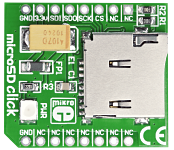
|
|
microSD Click is an accessory board, in mikroBus form factor, which features a microSD card connector. MicroSD cards are used as mass storage media for portable devices. They feature the industry standard SPI interface, which ensures simple communication at high data rates. The board is designed to use a 3.3V power supply only. |
|
|
|
 |
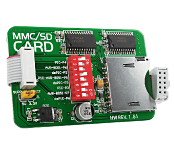
|
|
The MMC/SD Board is an effective and low-cost board used to connect a development system to MMC or SD cards. This board uses SPI communication for data write or read to/from MMC/SD card. It comes with many ready-to-use examples. |
|
|
|
 |

|
|
The Flash Click board is an accessory board in mikroBUS form factor. It's a compact and easy solution for adding flash memory to your device. It features M25P80 8Mbit serial Flash memory module with advanced hardware write protection mechanisms. It supports high-performance commands with a clock frequencies of up to 75MHz. Memory is divided into 16 sectors, each containing 256 pages. Flash Click communicates with the target board via an SPI interface. The board is designed to use a 3.3V power supply only. It has a green LED which indicates when the board is powered. |
|
|
|
 |

|
|
Flash 2 click is a mikroBUS add-on board for adding more Flash Memory to your target board microcontroller. It carries Microchip's SST26VF064B flash-memory module with 64 Mbits capacity. It's a highly reliable module with a specified minimum of 100,000 read and write cycles and with over 100 years of Data Retention. For data security, the module features a One-Time Programmable (OTP) 2 KB bit secure ID and a 64 bit unique, factory pre-programmed identifier. Additional software security measures include inidividual-block write Protection with permanent lock-down capability. Flash 2 click communicates with the target MCU through the mikroBUS SPI interface (CS#, SCK, MISO, MOSI) with additional functionality provided by the #HOLD pin (in place of default mikroBUS™ RST pin). The board is designed to use a 3.3V power supply. |
|
|
|
 |
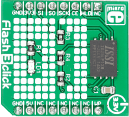
|
|
Flash 3 click is a mikroBUS add-on board for adding more Flash Memory to your target board microcontroller. It carries an ISSI IS25LP128 IC with 128 Mbit capacity.
The high-performance Flash chip operates at 50MHz at Normal and 133MHz at Fast Read speeds.
It is specified to standard 100,000 erase/program cycles with more than 20 years of data retention. The data can be erased in sectors or blocks and programmed with 1 to 256 bytes per page.
Each chip has a 128-bit unique ID for each device.
Flash 3 communicates with the target board through the mikroBUS SPI interface with additional functionality provided by HOLD, CE and WP pins. It is designed to use a 3.3V power supply only. |
|
|
|
 |
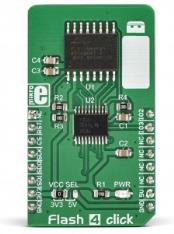
|
|
Flash 4 click is a perfect solution for the mass storage option in various embedded applications. With fast performance being one of its key features, Flash 4 click can also be used for the code shadowing, execute-in-place (XIP), and data storage. It features the S25FL512S Flash memory module made by combined high-performance MirrorBit® technology and Eclipse™ architecture. The 512 Mbit SPI Flash memory module is one of the fastest and most reliable Flash modules on the market.
It comes in the package which also includes the mikroSDK™ software and a library with all the functions. The Click board™ comes as a fully tested and approved prototype, making it a reliable device ready to use on the development board. |
|
|
|
 |
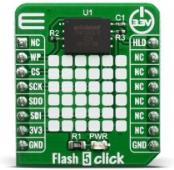
|
|
Flash 5 Click is a perfect solution for the mass storage option in various embedded applications. It features the W25N01GVZEIG/IT (1G-bit) Serial SLC NAND Flash Memory from Winbond which provides a storage solution for systems with limited space, pins and power. The W25N SpiFlash family incorporates the popular SPI interface and the traditional large NAND non-volatile memory space. They are ideal for code shadowing to RAM, executing code directly from Dual/Quad SPI (XIP) and storing voice, text and data.
The Flash 5 click is supported by a mikroSDK compliant library, which includes functions that simplify software development. This Click board™ comes as a fully tested product, ready to be used on a system equipped with the mikroBUS™ socket.
|
|
|
|
 |
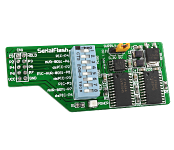
|
|
The SerialFlash Board provides additional memory space for your MCU. The M25P80 circuit provided on the board enables the MCU to use additional 8Mbit flash memory via a Serial Peripheral Interface (SPI). |
|
|
|
 |
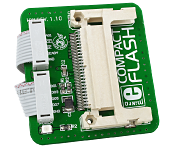
|
|
The Compact Flash Board allows you to connect your development or prototype board to the Compact Flash card. You just have to establish connection between these two devices in order to enable data write or read to/from the Compact Flash card. |
|
|
|
 |
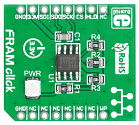
|
|
FRAM click brings 256Kbit (32,768 words x 8 bits) of Ferroelectric Random Access Memory to your design. It features the MB85RS256A module which uses the ferroelectric process and silicon gate CMOS technologies for forming the nonvolatile memory cells. It is able to retain data without using a back-up battery. The memory can be used for 10 bilion read/write operations and does not take long time to write data unlike Flash memories or EEPROM. It uses SPI to communicate with the target device. Maximum operating frequency is 25MHz. The board is designed to use 3.3V power supply only. |
|
|
|
 |
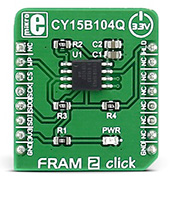
|
|
Additional memory for your next project!
FRAM 2 click carries the CY15B104Q 4-Mbit (512K x 8) serial F-RAM from Cypress. A ferroelectric random-access memory or F-RAM is non-volatile and performs reads and writes similar to a SRAM. You can access the memory using an industry-standard serial peripheral interface (SPI) bus.
On the functional level, the F-RAM operates in a similar way as serial flash and serial EEPROMs. The major difference between the CY15B104Q and a serial flash or EEPROM with the same pinout is the F-RAM's superior write performance, high endurance, and low power consumption. |
|
|
|
 |
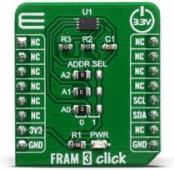
|
|
The FRAM 3 Click is a Click board™ that carries a ferroelectric RAM module. Ferroelectric RAM, also known as FRAM, is a non-volatile memory type, with characteristics that are comparable to much faster DRAM memory modules. It offers much faster alternative to common serial FLASH and EEPROM modules, which use the conventional technologies. FRAM 3 click uses the MB94R330, a serial FRAM module from Fujitsu Semiconductor LTD.
FRAM 3 click is supported by a mikroSDK compliant library, which includes functions that simplify software development. This Click board™ comes as a fully tested product, ready to be used on a system equipped with the mikroBUS™ socket.
|
|
|
|
 |
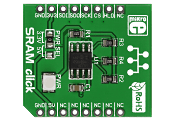
|
|
SRAM click lets you add 1Mbit of additional SRAM memory to your devices, via the 23LC1024 chip. It organizes the memory into 8-bit instruction registers and 32-byte pages. Three operating modes for reading and writing data are available: byte, page, and sequential (the last one allows read/write for the entire memory array). The clock rate for all three modes is up to 20MHz. The board communicates with the target MCU through the mikroBUS SPI interface (MISO, MOSI, SCK, CS) with additional HOLD functionality provided through the default mikroBUS RST pin. SRAM click is designed to use either a 3.3V or 5V power supply. |
|
|
|
 |
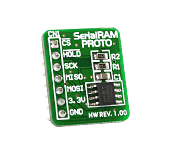
|
|
The SerialRAM PROTO Board enables you to add a 64Kbit Serial RAM device to your prototype device. A 23K640 Serial RAM device is available on-board and communicates with microcontrollers via a Serial Peripheral Interface (SPI). |
|
|
|
 |
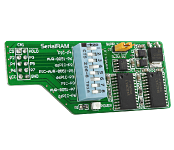
|
|
The SerialRAM Board enables you to use a 64Kbit Serial SRAM device with your development board. The board features the 23K640 Serial RAM device that communicates with microcontrollers via a Serial Peripheral Interface (SPI). |
|
|
|
 |
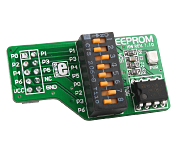
|
|
The EEPROM board contains the 24C08 serial EEPROM IC with 8Kbit of memory and I2C interface. It can be used with both 3.3V and 5V systems. |
|
|
|
 |
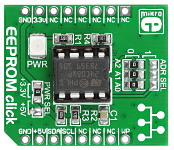
|
|
EEPROM click is an accessory board in mikroBus form factor. It features the 24C08WP highly reliable, high performance CMOS technology serial 8K EEPROM (in DIP package). It offers significant advantages in low-power and low-voltage applications. The 24C08WP EEPROM uses the I2C addressing protocol and 2-wire serial interface which includes a bidirectional serial data bus synchronized by the clock. Address selection SMD jumpers and a power LED are available on board. Another SMD jumper is available for selecting whether board will be operating on a 3.3V or 5V power supply. |
|
|
|
 |
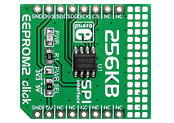
|
|
EEPROM 2 click carries ST’s M95M02-DR EEPROM chip with 256 KB of memory. The chip has byte and page write speeds equal or less than 10 ms. It's specified for more than 4 million write cycles, with more than 200 years of data retention. The memory, organized as 262144 x 8 bits, has an additional identification page, for storing sensitive application data which can be permanently locked in read-only mode. The board communicates with the target board MCU through the mikroBUS SPI interface (CS, SCK, MISO and MOSI pins). The board is designed to use either a 3.3V or a 5V power supply. |
|
|
|
 |

|
|
EEPROM3 click carries Atmel's AT24CM02 DIP-8 socket EEPROM chip with 256 KB of memory. The chip has byte and page write speeds equal or less than 10 ms. It's specified for a million write cycles, with 100 years of data retention. The memory, organized as 262144 x 8 bits. The board communicates with the target board MCU through the mikroBUS I2C interface (SCL, SDA pins) with speeds up to 1 MHz. An onboard jumper allows you to select the device address (two of them can be connected on the same I2C bus, for a total of 512 KB). The board is designed to use either a 3.3V or a 5V power supply. |
|
|
|
 |
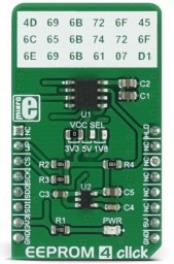
|
|
EEPROM 4 click is 2,097,152 bits on a click board™, organized into 262,144 bytes. In other words, this click board™ is an EEPROM memory medium with the capacity of 256 KB. The used EEPROM module has very good endurance and it can withstand 1,000,000 write cycles, with the data retaining period of about 40 years. The EEPROM module on this click can work with power supply voltage ranging from 1.7V to 5.5V, it features the self-timed write cycles, doesn't require erase before writing, has a dedicated write protect pin for hardware protection of stored data, and has a dedicated hold pin used for holding the data transfer.
EEPROM 4 click is aimed towards industrial and commercial applications, which require low voltage and low power operational capabilities. It can be used for any kind of temporary or permanent data storage for various embedded electronic devices, simple data logging, storing various working parameters of a module or device, safeguarding the sensitive data in case of a power cycle, and other similar applications where EEPROM memory is needed. |
|
|
|
 |
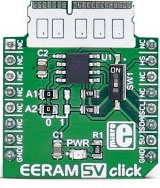
|
|
Add memory to your project with EERAM 5V click. It carries the 47C16 EERAM, a 16Kbit SRAM with EEPROM Backup from Microchip. The click is designed to run on a 5V power supply. It communicates with the target microcontroller over I2C interface, with additional functionality provided by the INT pin on the mikroBUS™ line. |
|
|
|
 |
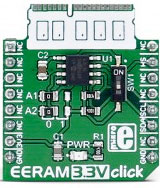
|
|
Add memory to your project with EERAM 3.3V click. It carries the 47L16 EERAM, a 16Kbit SRAM with EEPROM Backup from Microchip. The click is designed to run on a 3.3V power supply. It communicates with the target microcontroller over I2C interface, with additional functionality provided by the INT pin on the mikroBUS™ line. |
|
|
|
 |
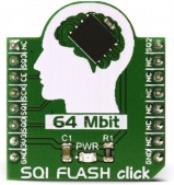
|
|
SQI FLASH click is based on the SST26VF064B, a 64 Mbit Serial Quad I/O flash device from Microchip. The chip utilizes 4-bit multiplexed I/O serial interface to boost the performance. The click is a very fast solid-state, non-volatile data storage medium, that can be electrically erased and reprogrammed. Operating at 104 MHz, the SST26VF064B enables minimum latency execute-in-place (XIP) capability, without the need for the code shadowing.
Features like the high performance and reliability, make the SQI Flash click the ideal choice for network appliances, DSL and cable modems, wireless network devices, automotive and any other applications, where high-speed reliable data storage is needed. Further benefits are achieved with its proprietary, high-performance CMOS SuperFlash® technology, which significantly improves the performance and reliability and lowers the power consumption. |
|
|
|
 |
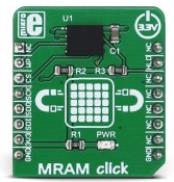
|
|
MRAM click features MRAM module which contains 262,144 magnetoresistive memory cells, organized into 32,768 bytes of memory. It means that MRAM click is a memory storage device with 32KB of memory space. The used memory module can withstand an unlimited number of write cycles, it has data retention period greater than 20 years and it can read and write to random addresses with no delay.
Besides these features that already mark this kind of memory modules a milestone in memory manufacturing technology, the device features data protection in case of power loss, block write protection, low power consumption and fast SPI interface that can theoretically work up to 40MHz. Because of its universal memory characteristics, MRAM click can be used both as a non-volatile storage media, or temporary RAM expansion for storing variables in any embedded application. |
|
|
|
 |

|
|
Secure Digital Card or SD Card is a very popular storage media, which offers huge amounts of storage area. SD Cards are on the market for quite some time. They are constantly evolving and improving, offering higher memory capacities, faster data rates, shorter access times, etc. The SD Card standard was first introduced in August 1999 by joint efforts between SanDisk, Panasonic (Matsushita Electric), and Toshiba, as an improvement over existing MultiMediaCards (MMC) standard. Since then, several revisions have been made. The microSD Card is the smallest SD Card version with the only 5mm in length and 11mm in width.
|
|
|
|
 |

|
|
ReRAM Click features ReRAM (Resistive Random Access Memory) module which contains the cell array made of 524.288 words x 8 bits, which totals 4 Mbits of data. The used memory module can withstand a large number of write cycles, it has data retention period greater than 10 years and it can read and write to random addresses with no delay. Besides these features that already mark this kind of memory modules a milestone in memory manufacturing technology, the device features block write protection, low power consumption and fast SPI interface that can theoretically work up to 5MHz. Because of its universal memory characteristics, ReRAM click can be used both as a non-volatile storage media, or temporary RAM expansion for storing variables in any embedded application.
ReRAM click is supported by a mikroSDK compliant library, which includes functions that simplify software development. This Click board™ comes as a fully tested product, ready to be used on a system equipped with the mikroBUS™ socket.
|
|
|
|
 |
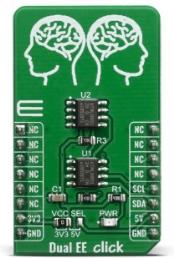
|
|
Dual EE Click contains two AT24CM02 EEPROM ICs onboard which gives total of 4MB of memory. Each memory IC can be addressed through the I2C interface with the transfer speed of 400KHz. This Click board™ offers any kind of temporary or permanent data storage for various. embedded electronic devices, as well as simple data logging or even storing various working parameters of a certain module or device. It can also safeguard all of the sensitive data in case of a particular power cycle and it has many other capabilities.
Dual EE click is supported by a mikroSDK compliant library, which includes functions that simplify software development. This Click board™ comes as a fully tested product, ready to be used on a system equipped with the mikroBUS™ socket.
|
|
|
|
 |
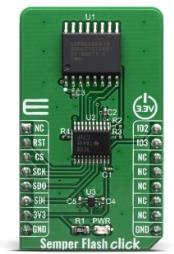
|
|
The Semper Flash Click is a Click board™ which features the S25HS512T, a perfect solution for the mass storage option in various embedded applications. With fast performance being one of its key features, Semper Flash click can also be used for the code shadowing, execute-in-place (XIP), data logging and data storage. The Cypress Semper Flash with Quad SPI family of products are high-speed CMOS, MirrorBit NOR flash devices. Semper Flash is designed for Functional Safety with development according to ISO 26262 standard to achieve ASIL-B compliance and ASIL-D readiness. Built-in Error Correcting Code (ECC) corrects Single-bit Error and detects Double-bit Error (SECDED) on memory array data. The 512 Mbit SPI Flash memory module is one of the fastest and most reliable Flash modules on the market.
The Semper Flash click is supported by a mikroSDK compliant library, which includes functions that simplify software development. This Click board™ comes as a fully tested product, ready to be used on a system equipped with the mikroBUS™ socket.
|
|
|
|
 |

